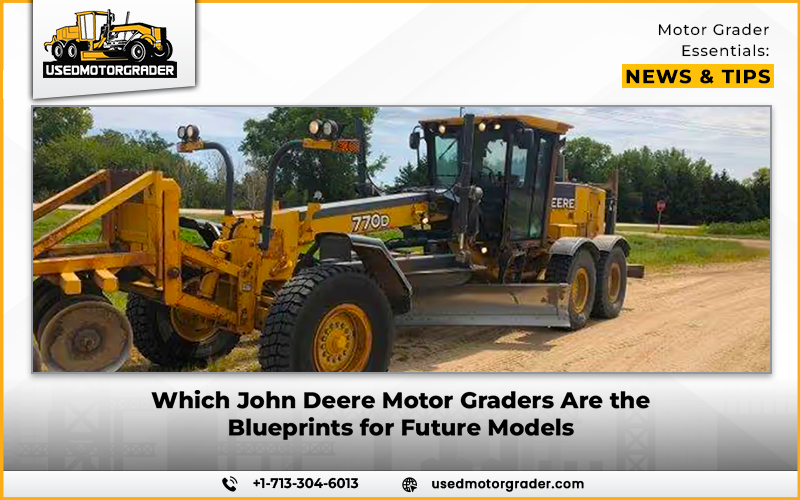As far as the future of road construction and earthmoving equipment is concerned, John Deere motor graders have evolved into more than mere machines. They have become a point of reference for innovation. Some models have proven so reliable, efficient, and advanced that experts consider them the standard future graders should follow. A combination of proven engineering and forward-looking technology, John Deere offers a product range that spans from advanced precision control to sustainability.
The Legacy of John Deere Motor Graders
John Deere has a reputation for adjusting its machines to the changing construction demands. The company has, over the decades, come up with graders that not only satisfy the industry requirements but, in most cases, surpass them. The initial models established the foundation with durability and ruggedness, whereas subsequent generations brought in superior hydraulics, enhanced operator comfort, and integrated technology.
This heritage of constant evolution has made John Deere graders much more than workhorses. They are industry trendsetters that contractors can trust.
Key Models That Serve as Blueprints
Certain John Deere models can be regarded as a benchmark of the new generation. These graders are a combination of the ideal balance of performance, control, and adaptability.
670G/GP: This model is very versatile and can be used in both small and mid-scale projects with balanced power and efficiency.
770G/GP: A productivity powerhouse, this grader is preferred in larger projects, and it gives consistent performance in challenging site conditions.
872G/GP: This model is designed with high-tech operator comfort and improved hydraulics, which makes it a favorite among contractors who require high output and operator comfort.
John Deere SmartGrade Models: The next generation of grading, with an integrated grade control system that does not require external masts or cables.
All of these machines are part of the John Deere vision of the future, addressing the needs of the contractor in the real world.
Blueprint Features Shaping the Future
The above models are not only successful in themselves, but they also form the basis of future machine design.
- Accurate control systems that enhance grading precision.
- Economic engines that lower operational expenses.
- High-tech operator-aid systems, such as automated blade control.
- Strengthened frames and hydraulic reinforcements to ensure long life.
- Digitalization with telematics and fleet management systems.
These features are now becoming necessities as opposed to optional extras, and John Deere has established industry standards.
Why These Models Stand Out
Why are these graders selected as the models of the future? The solution is in their performance, flexibility, and worldwide acceptance.
- They have a tested history of use in a variety of job-site conditions, including roadbuilding and mining.
- They are very compatible with new technologies such as automation.
- Their high resale value says a lot about their dependability
- Contractors all over the world prefer them because they balance operator comfort with job efficiency.
In short, these models are both durable and innovative, a combination that is hard to beat.
Influence on Future Graders
These blueprint models will have a lot of influence on the next generation of John Deere motor graders.
- Technological innovation: There will be more automation, enhanced telematics, and AI-aided controls.
- Design influence: Ergonomic operator cabins with better visibility and easier access to maintenance.
- Sustainability inspiration: Hybrid power solutions and emission-compliant engines to comply with environmental regulations in different parts of the world.
By improving what is already good and by adding the latest technology, John Deere is setting itself up for the future of construction equipment.
Market Perspective: What Buyers Look For
The grading equipment industry is evolving, and John Deere is one of the first to adapt. Customers now prioritize the long-term value of operations over short-term costs.
- Contractors are becoming more and more demanding of fuel efficiency to cut down on the project costs.
- Integrated grade control systems have become a determining factor in most purchases.
- The costs in the lifecycle, such as resale value and maintenance, are given more importance than the price.
This transition explains why the blueprint models of John Deere are so powerful–they already provide what the market wants.
Challenges Ahead for John Deere’s Next-Gen Graders
There are still difficulties despite good blueprint models.
- Cost-effectiveness and high-end functionality: how to combine technology with making machines affordable.
- Tighter emission standards mandate greener engineering
- Addressing the demands of both international contractors with large fleets and smaller companies with a tighter budget.
Overcoming these challenges will be critical to the future success of the next generation of graders to continue to establish industry standards.
FAQs
Q1. What is the most advanced model of a John Deere grader currently?
A: The SmartGrade graders, including the 872G/GP with integrated grade control, are the most advanced, providing unrivaled precision and efficiency.
Q2. Why are SmartGrade-equipped graders a blueprint of the future?
A: They do not require external grade control systems, saving time on setup and improving accuracy, making them a cost-effective and future-ready option.
Q3. How do John Deere motor graders hold up against the competition in long-term reliability?
A: Contractors know John Deere machines for their high reliability, good resale value, and greater life cycle economy compared to competitors.
Q4. Are hybrid or electric John Deere graders expected soon?
A: Although they are not yet widely available, industry trends and John Deere’s sustainability goals indicate that hybrid and electric options are likely to be available in the near future.


